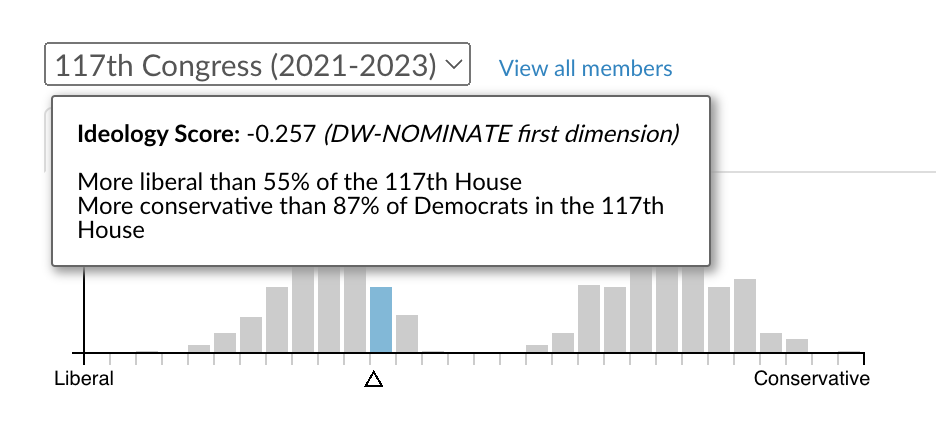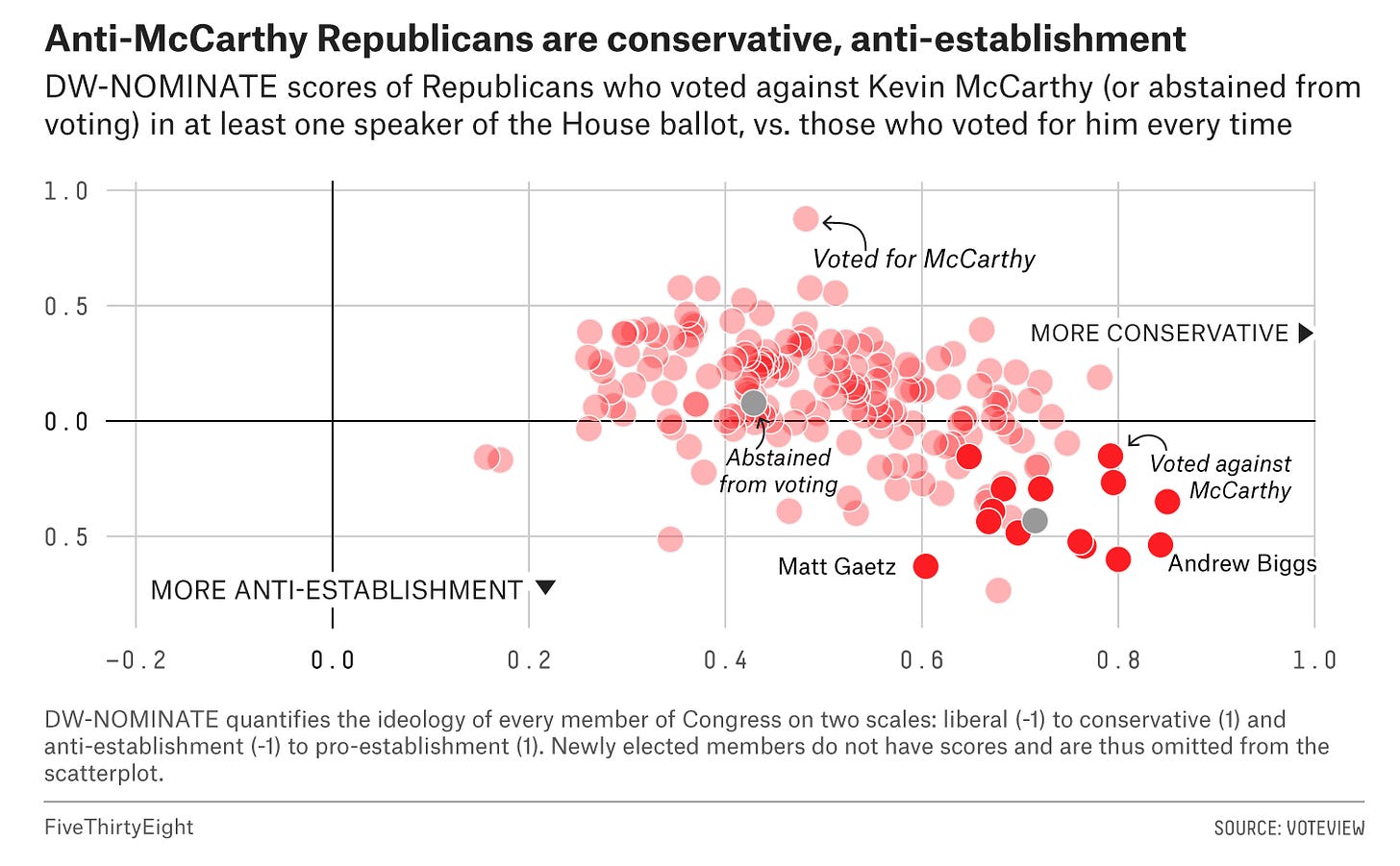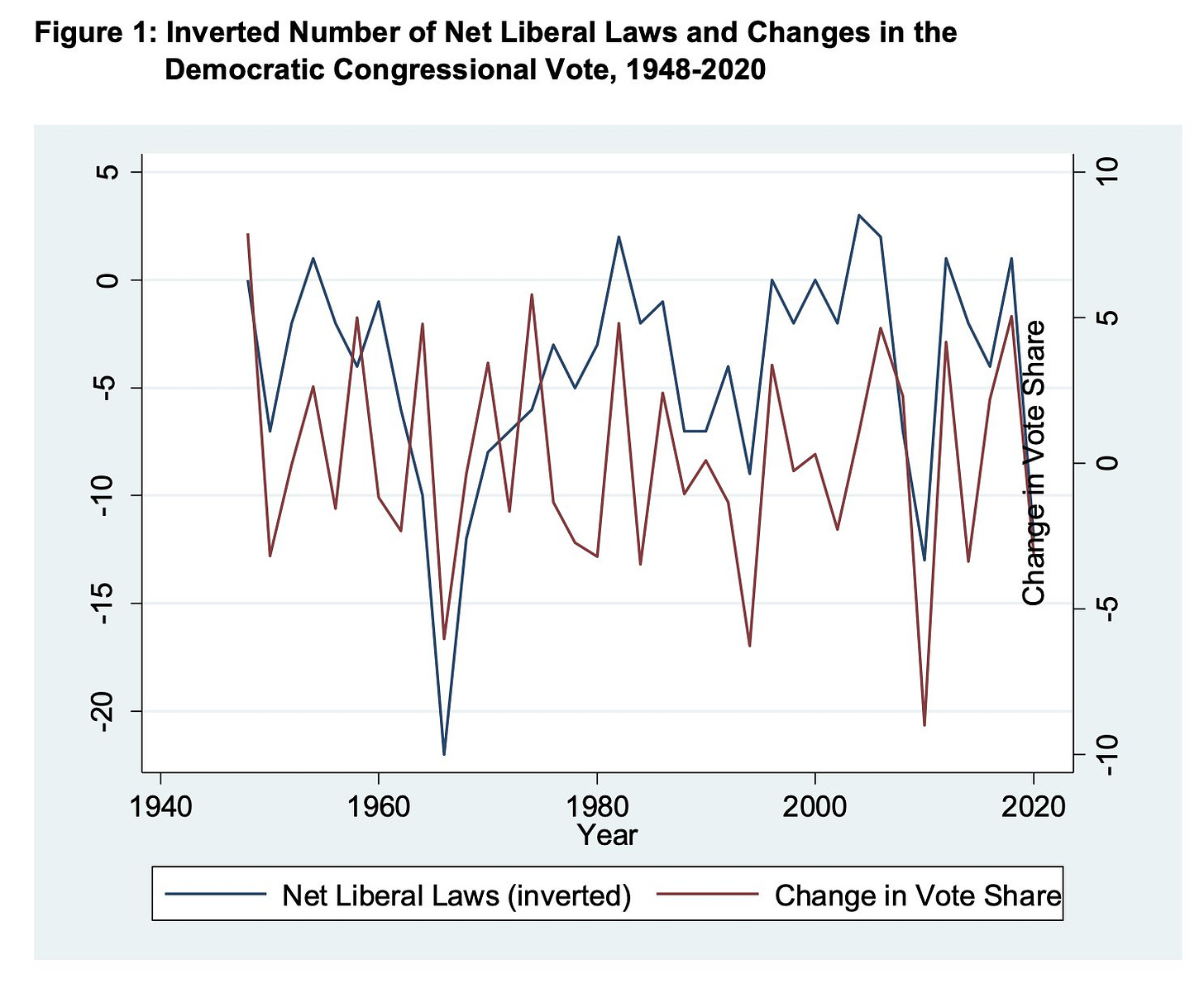Links for January 1-7, 2023 | Polarization in the US House; The "chaos caucus"; Midterm backlashes; And a belated Happy New Year
Kevin McCarthy, call your office
Happy Sunday, subscribers, and a belated Happy New Year to you all. My 2022 was better than 2021 and I hope we can continue the positive trend.
This post is my regular weekly roundup of articles/books/charts etc. I’ve read and media I’ve watched over the last 7 days that I think are interesting and worth a fun discussion.
The first point this week is a bit atypically in the weeds. You’ve been warned.
1. A popular measure of partisan polarization in America is underestimating the true depth of the Congressional divide
Befriend an expert on the American Congress or the history of our party politics and it is only a matter of time before they mention the phrase “DW-NOMINATE.” It’s an “algorithm,” they tell you, that captures the ideology of every member of Congress based on how they vote, you see. Developed by political scientists Keith T. Poole and the late Howard Rosenthal in the 1980s and 90s, DW-NOMINATE scores can tell us that Mick Mulvaney is more conservative than, say, Adam Kinzinger. At least, that was true from 2011 to 2013 during their first terms in the chamber.
But the thing about algorithms is that, by simplifying the rules of the world, they have a tendency to strip out nuances and make poor predictions on edge cases. This problem is especially salient when making predictions on unseen observations from the future. And that’s where this particular problem comes from.
A strict reading of the scores today tells us that progressive Democratic House members of the so-called “squad” are actually more moderate than most of their colleagues on the traditional left-right political axis. You can see this below; the highlighted example Congresspeople fall to the right of most of their Democratic colleagues:
But I would submit for the record that this is not true! (or maybe we just don’t believe it). It is possible that, in some abstraction of reality, Alexandria Ocasio-Cortez is a moderate and Mary Peltola is a closet socialist. But that reality is not the one we are living on today. Instead, what’s happening is the DW-NOMINATE algorithm is failing to capture a nuance of the way members of the squad vote.
You see, my dear friend of the imaginary 1st-year poli sci PhD student, the computer program that computes these “ideology” scores does so by engaging in a very complicated set of comparisons of each legislator based on their voting records. Each time a member of Congress votes, for instance, with the most ideologically liberal member of the chamber, the algorithm gives them a more progressive score on its scoring system. (For the nerds reading this: yes I am aware this is an oversimplification, but please for now just play nice for the rest of the audience.) But what happens if a Democratic member of Congress votes against a liberal law because they think it is not liberal enough, rather than because they want a more conservative piece of legislation?
Well, the algorithm doesn’t know that, and so it gives them a more moderate score — at least on that left-right axis of DW-NOMINATE. And that’s why AOC and her most progressive colleagues look like moderates on the chart above, but actually aren’t.
OK, but why am I going on about this in the first place? Well, one point is that as currently configured, DW-NOMINATE may be underestimating our political divide by putting the most extreme members of Congress closer together due to these meaningful no votes.
The second reason is that Nathaniel Rakich, an elections writer for FiveThirtyEight, recently published this graph in an article about Kevin McCarthy’s tough battle for Speaker of the House:
The chart plots each Republican congressperson in 2-dimensional space. A GOP representative gets placed more to the right of the graph if they are more “conservative” on votes that we typically think of as economic or have to do with government spending and social programs. Then, they get placed lower on the graph if they are more “anti-establishment”. That score is based on another calculation being done by the NOMINATE computer program which analyses votes that do not fall under the traditional left-right issue space.
At least, that’s how Rakich is interpreting the score. And it makes sense on paper! Republicans who initially opposed Kevin McCarthy’s bid for House Speaker such as Andy Biggs and Matt Gaetz are placed in the ultra-conservative, anti-establishment part of the chart. But so is Marjorie Taylor Greene, who supported McCarthy’s bid from the get-go — in fact, she may even be credited for pushing him across the finish line in the late hours of Friday night. (For reference, she is the light pink dot just to the bottom of Matt Gaetz’s point.)
But this is not a point to be taken for granted. There is much debate in the literature on DW-NOMINATE about what exactly this second dimension is capturing. Originally, it was thought to effectively be a score of how left- or right-leaning a member was on racial issues. It has also been called a score of cultural progressivism; eg, of capturing a member’s views on race as well as on things such as LGBTQ rights and other “social” issues. Yet in reality, it is not directly capturing any of this. See, the second dimension is in fact just a residual score (and one of many, I might add). I suspect I may lose some readers if I go on, but what you need to know is that the dimension captures some of a legislator’s “weird” (or perhaps “counterintuitive”) voting behavior that cannot be explained by the first-dimension score.
However, describing the current crop of the so-called “#ChaosCaucus” Republicans as both ultra-conservative and anti-establishment does not feel wrong at this moment. But keep in mind that the second dimension may capture something different in the future. Due to the way DW-NOMINATE is calculated, the precise meaning of each dimension depends on what issues are being taken up in Congress.
2. Why do Congressional backlashes happen, anyway?
Political scientists Matt Grossmann and Chris Wlezien suspect part of the answer is legislative overreach. In a new paper, they correlate the change in the incumbent party’s share of the two-party vote for the House with the number of net liberal (or conservative) laws passed by each Congress. The offer this graph:
This is really pretty neat, but what I love about the paper is that they spend time exploring their model’s errors. Since all models abstract, and abstraction introduces noise, that is a good thing to spend some time on! Especially when the subject is Congressional outcomes — oh, so, juicy. So Grossmann and Wlezien take about a dozen pages out of their paper to review both the accuracy of the model and the qualitative narratives of each election in their dataset. By doing so they can show how unquantifiable factors push their model off course. As someone who makes a lot of election forecasts for my day job, this is as close as political science usually gets to preaching to the choir (at least, this choir of N=1).
3. Also, I re-read Orwell’s “Animal Farm” this week.
My original take stands. It is fine. Conditioning on being an animal in the story I am obviously #TeamSnowball.
4. Happy New Year
Finally, just a few remarks about the new year. Science tells us that most resolutions are doomed to fail, yet I have made a few anyway. One professional goal is to do more of what gives me energy — namely, reading both social science and political theory and writing about it — as focusing on the daily drum of polling and election news can be more than a little exhausting. I hope those efforts may produce some fruit for the blog.
A second goal is to go outside more. I have a (small) office here in our home in suburban Washington, DC, which tempts me to stay in all day and read. But we are surrounded by trees and a generous network of paths through the neighborhood, so I have resolved to take the dog on more walks…. Just as soon as it warms up outside. Here she is pictured outside the closest coffee shop:
So Happy New Year to all!
And in case you missed it, here is my post about Kevin McCarthy and the #NeverKeving members of the Republican Conference from earlier in the week.









